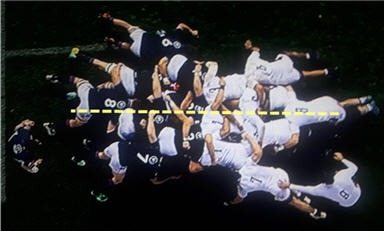You may have heard commentators refer to the “brake foot” when scrums pack down in recent rugby matches.
If I told you that this was to prevent “axial loading”, then you may be none the wiser! This article explains both concepts in plain language.
Before we get to the brake foot, we’ll explain why the rugby authorities are so concerned about axial loading in scrums.
What Does Axial Loading Mean?
Axial loading refers to applying force directly along the axis of any structure.
In terms of axial loading on the spine, think of someone standing upright. If a gym weight was pressed down on the top of the person’s head, this is axial loading on the spine.
Of course with scrums, players lean forward so that they are horizontal. Pressure from the opposition forwards provide axial loading on the necks and shoulders of their opposite number.
The yellow line in the picture below shows axial load in the scrum.

However, we would expect that pressure to be spread across the three members of the front row. This reduces the load on any single player.
The problem is that coaches and players are always looking for an advantage over the opposition.
The front row started to adjust how they were scrummaging to target and increase the axial load on the player in the middle of the front row.
In other words, the hooker started taking the brunt of the force of the entire opposing pack.
How Did Axial Loading Become A Problem In Scrums?
When the forwards pack down to scrum, the referee controls the timing with a series of words.
The scrum sequence has been altered several times in recent history. You can read more about how this developed in our article on referee scrum calls.
To summarize here, the current sequence is “Crouch…Bind…Set”.
So, how did axial loading increase with this sequence?
When the referee says “bind”, hookers started to push their heads onto the shoulder of their opposite number.
This provided a focal point for the pressure applied by the pack behind him.
It greatly increased the axial load on the opposition hooker.
Several international hookers and rugby medics started raising concerns about this.
Here is what former Ireland hooker Mike Ross had to say.
On the bind, the hooker and props put their feet back, and most of the weight was loaded onto the hooker, through his neck and head, and onto the shoulder of the opposing hooker.
The team doing the “axial loading” enjoys their advantage.
Obviously, this kills (eventually) the hooker’s neck.
Mike Ross on Twitter
Unknown consequences
Ross is making the point here that the consequences may not be an immediate injury.
But the toll from hundreds of scrums over several years may result in long-term issues in later life.
(If you’re curious, we have an article on the number of scrums per match).
Scrum Research
World Rugby convened a meeting in the summer of 2019 to discuss injury prevention.
The authorities were presented with research from several groups including the RFU, the English professional clubs), the New Zealand Rugby Union, and the Rugby Players Association.
The research groups had consulted with highly experienced hookers like Rory best, the recently retired Irish captain.
Ken Owens of Wales and Jamie George of England were amongst the current hookers who were consulted. All Black Dane Coles was also involved.
The conclusion at this meeting was that there were potentially dangerous levels of axial loading in scrums due to the actions of hookers.
Axial Loading Is Now Illegal In Scrums
World Rugby moved quickly after the June 2019 meeting.
They amended the scrum laws the following month. The new clause prevents hookers from placing their heads against their opponent’s shoulder after the “bind” call.
This is the relevant piece:
The front-rows crouch with their heads to the left of their immediate opponents, so that no player’s head is touching the neck or shoulders of an opponent.
World Rugby Law 19.10 (b)
World Rugby instructed referees to watch out for this practice and penalize it with a free kick.
A repeat offense would bring a penalty. If the front row didn’t get the message, a yellow card would ensue.
This was welcomed although some hookers in the game felt that it should have been acted upon sooner.
Scott Baldwin, the Welsh hooker, commented somewhat sarcastically that it had “only taken 3-4 years to change it – better late than never.”
What Does The Brake Foot Mean?
Although the laws changed in 2019 to prevent players from boring their heads into their opponent’s shoulders, there was still concern that axial loading wasn’t reduced enough.

So, a new amendment to scrums was trialed in the 2022 Six Nations championship. This is referred to as the “brake foot”.
Honestly, when I first heard the TV commentators refer to it – I thought they were saying “break foot”. I wondered if the opposition front row was now allowed to stamp on their rivals. Back to the old days, eh?
But no, it’s completely different.
What is the brake foot?
The “brake foot” requires hookers to extend one foot towards the opposition when they bind. This is the brake foot.
Hookers will crouch as normal. When the referees say “bind”, hookers no longer move both of their feet back. Now, they have to keep one foot in front of the other.
The goal is to reduce the amount of force being transferred from the pack through the hooker and onto the neck of their opposite number.
So, the foot is acting as a brake on axial loading we discussed earlier.
If referees don’t see a hooker with a brake foot, they will award a free kick.
Still on trial

We don’t know yet if the brake foot will work in the way that World Rugby wants it to.
The effects will be monitored by their medical research team. This could take several tournaments before a decision is made.
The authorities are also hoping that the brake foot will make the scrum more stable. Of course, collapsed scrums are potentially dangerous for the front row.
And if the brake foot takes endless resets out of the game, spectators will be very happy!